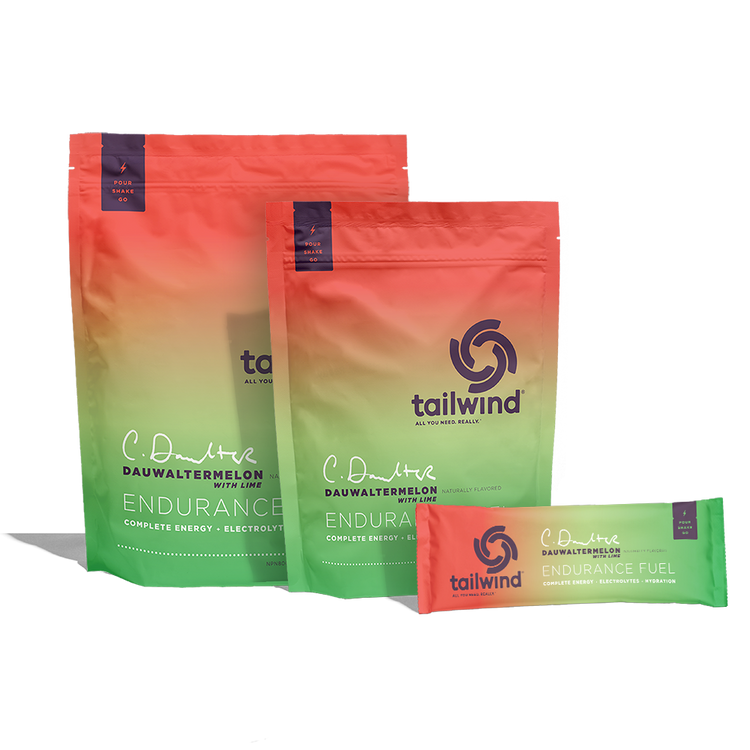How to Choose a Hydration System
0 Comments
If you’re new to the concept of liquid fueling, you might be wondering what hydration system you should use on a run, ride, hike, etc.
There are a lot of options out there and knowing what to use and when to use it can be overwhelming! Lucky for you, we created this guide to help you choose a hydration system that works best for you.
Bike Bottle
Pros:- Great for road cycling, mountain biking, hiking with a pack, or an indoor/stationary workout.
- A standard 24 oz bike bottle holds an hours worth of Endurance Fuel, which makes calculations easy!
- This is one of the most affordable options.
- The wide mouth makes filling Endurance Fuel or Rebuild Recovery a breeze!
Cons:
- You need a bottle cage on your bike to use these on an outdoor ride.
Our recommendation: Our awesome Tailwind bottles of course!

Handheld Flask
Pros:
- Primarily for running, but could also be used for hiking as well.
- Some options come with a hand strap for ease of carrying and small pockets for storage.
- Soft flasks are another inexpensive option.
Cons:
- The smaller mouth requires more care when adding Endurance Fuel and water (but a funnel can easily solve this problem).
- Soft flasks generally have smaller carrying capacities, so are best suited for short runs or races with frequent aid stations.
Our recommendation: Tailwind Hydrapak UltraFlask

Small Handheld (less than 10 oz)
Pros:
- Perfectly suited for the concentrate method when carrying capacity is limited or you want to eliminate having to re-mix your fuel.Best suited for road running/racing with frequent aid stations to supplement plain water.
- The small size makes them easy to stow/pack!
Cons:
- These would not work for carrying Endurance Fuel mixed at the traditional strength.
Our recommendation: Hydrapak 150mL Softflask

Running Vest/Backpack
Pros:
- Whether you use a bladder and hose or soft flasks, this system is best suited for longer runs, mountain bike rides, or hikes.
- Larger carrying capacity allows you to travel long distances unsupported or race with spaced out aid stations.
- Extra space to pack all sorts of goodies (layers, phone, clean socks, sunscreen, etc.)
- These total pack carrying capacities can range from 1 L to upwards of 15 L. Plenty of options to choose what is best for you!
Cons:
- Wearing something on your back means you’ll be moving slower and sweating more.
- These aren’t cheap; a good race vest is definitely an investment, but spend the money to get one that fits you well and doesn’t bounce or chafe.
Our recommendation: Our team's favorite running vests are from Salomon and Nathan!

Waist Belt
Pros:
- Specific to running, the waist belt keeps your hands free and still allows you to stash a phone and other small items.
- Pair with a soft flask or small handheld.
- Cheaper than a vest, but still allows you to carry some items.
Cons:
- More prone to bouncing and moving than a vest.
- Again, sweating will always be a consideration if you are wearing something on your body.
Our recommendation: Naked Running Band

Unbreakable Wide Mouth Bottle
Pros:
- The classic burly bottle, unbreakable wide mouth bottles are best suited for intervals, track workouts, indoor workouts, or hiking.
- One bottle usually holds 32oz - i.e. about an hour and a half of Endurance Fuel!
- Cheap, durable and utilitarian; these bottles can get beat up and kicked around.
- Half a 32oz bottle is perfect for a serving of Rebuild Recovery.
Cons:
- Usually too large and bulky to carry on a run or ride.
Our suggestion: Hundreds of Nalgene bottles to choose from, including customizable options!

We’re Your Support Crew
Don’t forget to wash and clean your bottles after every use.
Do you have a question or brilliant suggestion to add to this post? Please drop a note in the comments or reach out to us at supportcrew@tailwindnutrition.com.






